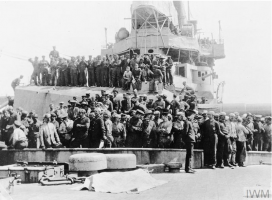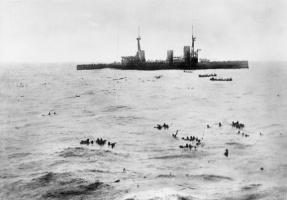Origins↑
HMS Invincible was one of the first class of three battlecruisers and was laid down in April 1906 and completed in March 1908. The battlecruiser was developed in response to the increasing size, power, and cost of traditional cruisers and British financial difficulties in building a sufficient number of cruisers to protect their worldwide trade routes. Admiral Sir John Fisher (1841-1920), First Sea Lord from 1904-1910, wanted a fast and powerful ship that could defeat the cruisers of potential foreign foes. Technological developments such as turbine engines and the use of oil fuel meant that the difference between so-called “fast battleships” and armored cruisers was steadily narrowing. Turbine engines were particularly important as they enabled a ship to sustain high speeds far longer than in the past. The battlecruiser would have the 12-inch guns carried by traditional battleships but was a few knots faster. To achieve the latter, armor protection was reduced. The battlecruiser could thus fulfill different missions: in addition to countering foreign cruisers on trade routes, they could be employed with the main fleet as a fast wing or advanced scouting force.
HMS Invincible had a primary armament of eight 12-inch guns in four turrets and a secondary armament of sixteen 4-inch guns and five torpedo tubes. The 4-inch guns were to counter potential attacks by torpedo craft. The ship was capable of a speed of 25 knots. The Invincible class was followed by larger and even more powerfully armed battlecruisers with 13.5-inch guns and 28 knots speed. By the outbreak of war in 1914, the British had completed nine battlecruisers with a tenth close to completion.
Wartime Experience↑
How well did the battlercruisers meet the challenge of war? The results are mixed and the subject controversial. HMS Invincible and her sister ship HMS Inflexible were the main component of Admiral Sir Doveton Sturdee’s (1859-1925) force which annihilated the German squadron of Admiral Maximilian von Spee (1861-1914) off the Falkland Islands in December 1914. Here battlecruisers did what they were designed to do: overwhelm powerful armored cruisers. However, at the Battle of Jutland, HMS Invincible, flagship of the 3rd Battlecruiser Squadron, blew up after sustaining a few hits. There were only six survivors out of a crew of over a thousand. Two other British battlecruisers were lost that day in a similar fashion. Critics were quick to condemn the battlecruiser type as an expensive folly. However, after a subsequent inquest, the Admiralty concluded the horrific losses were not necessarily due to inadequate armor protection but were caused by hazardous practices in handling ammunition. Safeguards had been disregarded in order to increase the rate of fire with disastrous results. The argument over the wisdom and utility of the battlecruiser remains to this day.
Paul G. Halpern, Florida State University
Section Editor: Jennifer Wellington
Selected Bibliography
- Campbell, N. J. M.: Jutland. An analysis of the fighting, Annapolis 1986: Naval Institute Press.
- Friedman, Norman: The British battleship 1906-1946, Annapolis 2015: Seaforth Publishing.
- Lambert, Nicholas A.: Sir John Fisher's naval revolution, Columbia 1999: University of South Carolina Press.
- Sumida, Jon Tetsuro: In defence of naval supremacy. Financial limitation, technological innovation and British naval policy, 1889-1914, London; New York 1993: Routledge.
- Tarrant, V. E.: Battlecruiser Invincible: the history of the first battlecruiser, 1909-16, Annapolis 1986: Naval Institute Press.











